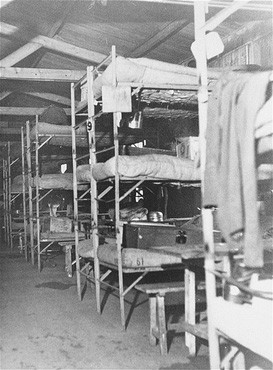
2nd Canadian Division
As Allied troops moved across Europe against Nazi Germany, they encountered concentration camps, mass graves, and other sites of Nazi crimes. Though liberation of Nazi camps was not a primary objective of the Allied military campaign, Soviet, US, British, and Canadian troops freed prisoners from their SS guards, provided aid to survivors, and collected evidence.
The 2nd Canadian Division first battled the Germans during the abortive landings in August 1942 on the coast of France at Dieppe, the "dress rehearsal" for the invasion of the continent nearly two years later. In July 1944, the 2nd Canadian Division landed in France, fought to liberate Caen, and then participated in the encirclement of the remnants of the German army in Normandy at the Falaise Gap. During the pursuit of the defeated enemy toward the Reich, the Canadians liberated Dieppe, then helped clear the Scheldt River estuary to open the port of Antwerp for the Allies.
After wintering in defensive positions in the Netherlands, the Canadians fought through the Reichswald forest toward the Rhine. They crossed the river on March 28 and spearheaded the drive of British and other Commonwealth troops toward the North Sea. While clearing the eastern Netherlands of German forces, they liberated the Westerbork transit camp, which was situated in the northeastern Dutch province of Drenthe, near the towns of Westerbork and Assen.
With some of the funding originating from Jewish sources, the Dutch government had established a camp at Westerbork in October 1939 to house refugees, most of whom were Jewish, who had sought refuge in the Netherlands. Some of these refugees, of whom there were 400 when the Germans invaded the Netherlands in May 1940, had entered the country illegally. After the Germans conquered the Netherlands in May 1940, the Dutch authorities continued to manage the camp. In 1941, some 1,100 Jewish refugees, most of them from Germany, resided in the camp. On July 15, 1942, German authorities took over the Westerbork camp, which at this time had approximately 1500 prisoners. After July 15, 1942, Westerbork served as a transit camp for Dutch Jews before their deportation to the killing centers in Auschwitz and Sobibor and to several concentration camps. Ninety-eight trains transported approximately 100,131 Dutch Jews to Auschwitz, Sobibor, Mauthausen, Bergen-Belsen, and Theresienstadt between July 1942 and September 1944.

As Allied troops approached the camp, the Germans abandoned Westerbork. When members of the Canadian 2nd Division reached Westerbork on April 12, 1945, they found between 876 and 909 inmates there, of whom the majority were Dutch Jews. In addition to the tens of thousands of deportees whom the Germans murdered on their arrival from the Westerbork transit camp between 1942 and 1944, around 750 Jews perished inside the facility during the five years of German occupation.
Following the liberation of Westerbork, the Canadian 2nd Division continued its advance into northern Germany. It captured the German city of Oldenburg on May 3 and was stationed there when the Germans surrendered on May, 1945.
Critical Thinking Questions
- What challenges did the Allied forces face when they encountered the camps?
- What challenges immediately faced survivors of the Holocaust?
- What options, if any, does a nation have when it learns of atrocities in other countries?

